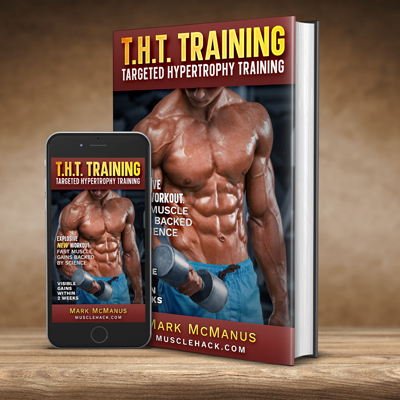 Maximizing muscle fiber recruitment and growth stimulation is actually quite easy when it comes to the calves.
Maximizing muscle fiber recruitment and growth stimulation is actually quite easy when it comes to the calves.
People often complain that the calves are stubborn but they really aren’t. People just train them incorrectly.
Think about it: The calves get low-intensity work pretty much all day long (unless you’re lying in bed all day).
What’s NOT needed is high volume and low-intensity, but rather a low volume of VERY high-intensity work. Then once the growth stimulation has been brought to the muscle, give it time for the overcompensation/growth to occur before working them again (see “finding your P.O.P.“).
When intelligent trainers speak about growth taking place outside of the gym during rest periods, it’s not something someone made up to excuse laziness, it’s a cold, hard fact.
If you were to cut your arm with a knife you’d naturally expect it to heal up in the days after you made the incision, right?
Furthermore, you’d know that any further cuts made to the same wound BEFORE it had fully recovered would PREVENT it from healing. Remember that analogy when it comes to working your calves, or any muscle for that matter. (note: cardio, especially high-intensity cardio, counts as a small “cut”, so take it easy when bulking up).
Ok, so let’s have a quick reminder of the rules of maximum muscle fiber recruitment:
- Work the muscle along the path of its FUNCTION
- Ensure there is resistance at the PEAK CONTRACTION POINT (PCP) as this is the part of the rep where maximum fiber recruitment occurs
So you want to know the function of the calves now, right?
Good question. Basically our calves are responsible for plantarflexion of the ankle joint. Plantarflexion? Stand on your tips of your toes; that’s what it is. Of course you do this to a smaller degree every time you walk as well.
So how do we do this and ensure there is resistance at the PCP? Good old Calf Raises are all that’s needed.
Since I train at home and don’t have a dedicated calf raise machine, I came up with a way to use my smith machine to perform Seated Calf Raises. Check out the vid…
* The balls of your feet should be just on the edge of the foot rest. This will allow you to achieve a full contraction.
* Make sure you pause at the PCP like I’m doing in the clip.
* TIP! When you ‘think’ you’re at the top of the rep, try to push up an inch higher!
* Just like training the abs, you’ve probably been told to “squeeze” the calf muscles at the top of the rep. The fact is that if you can VOLUNTARILY squeeze the muscle, the weight is too light. The correct load should FORCE a hard contraction in the fully contracted position.
* Train to muscular failure
* Use a heavy weight. Most people are shocked at how much they can lift with their calves
You can perform standing calf raises if you wish. The seated position involves the soleus muscle more so I prefer it. I’m also able to concentrate better in a seated position for some reason. The intensity caused by such heavy weights can be extreme, so it warrants all your will power to stick with it to failure.
Like all other muscle groups, choose a weight that causes you to reach failure within the “Anabolic Window“.
Stay Motivated!
Mark
P.S. Judging from previous articles, someone’s gonna ask below what equipment I’m using. It’s called “Marcy MP3100”. Although I don’t know if it’s available in the US, this one looks very similar to it (just confirm that it has a low pulley if you are interested in buying it).

Love the old school air maxes man! Rated five-o!
Very clever!
One thing I feel about calf training–people quit too soon during a set. They start to feel a little discomfort in the calves and they stop the set at that point. What I do is “go beyond” and push out every last rep. I’ve seen great changes in my calves using this technique. Nice article!
Yavor. lol. I think my whole outfit is quite stylish actually. Filmed this first thing this morning, grabbed whatever comfortable gear I could find and shot it.
Love training in my Nike’s though, very comfy.
@Carl. Cheers, works a treat!
@Mike. That’s exactly what happens with most people.
Mark, so standing calf lifts no more?btw great continuos posts about muscle individualization..cheers
Hey Mark … as you noted, seated calf raises tend to target the Soleus muscle more. As the Gastrocs are the larger muscle group, wouldn’t standing leg raises be the preferred method if we are mainly looking for a gain in size/mass?
Cheers!
Mark – another “blaster” of a workout! I’m doing 3 weeks of these and then 1 week of standing calf raises (weight-stack universal machine) and that seems to “flip” my training on its head nicely. Things are coming along well now.
You, sir, rock. Keep training and posting!
This is great. I was taught long ago by my trainer (a crazy bodybuilder in his own right) that you have to blast the heck out of your calves to get ANY difference. Being a taller guy, I have the chicken leg syndrome, so I’m usually the guy in the gym treating my calve workout like a chest workout (intense).
One thing I’ll add to this movement (and any calve exercise), is performing a “catcher’s lift” RIGHT after. I don’t know how else to explain it. When you’ve finished your exercise with heavy weight, the idea is to blast the muscle farther with body weight. Imagine a baseball catcher’s position, but rather than an open stance, lock your knees together. I usually hold onto a machine so you don’t have to worry about balance. Now squeeze the calve muscle as hard as you can in that position. I usually do about 30-40. Having the legs full bent, the movement forces blood into the muscle. Remember to do each set right after a heavy calve exercise set.
Hope this helps! Try it!
I usually preferred doing standing calf raises, but after some extensive research I came to the same conclusion as you did. Seated Calf Raises stimulate the Soleus much more. I like the idea of pushing up higher when I ‘think’ I’m at the top. Will give it a try. Thanks Mark
Hey mark
im ooking for equipment like that. does the Marcy MP3100 cover everything and do you have any additions?
For the seated/standing confusion…
I’ve left it open in the article for the reader to choose. The seated version will involve the soleus more if that’s what you want. Standing does target the gastrocnemius better soley.
Either way you can perform them with a smith machine, I’ve just chosen to demonstrate the seated version since the standing one should be fairly self-explanatory.
If you were a competitive bodybuilder I would advise the standing version most of the time, and infrequently alternating with the seated calf raise.
I don’t compete and have no interest in doing so, so most of the time I’ll perform the seated calf raise with the odd standing for gastro targeting.
If you just want to make each body part as big as possible use the competitive bodybuilder advice above.
@Jason. Yes it does mate. The only other thing I’m using these days is a dumbbell for wrist curls. Great piece of equipment.
Mark
Hi Mark
Nice tip on using smith machine for stnding calf raises. What do you make of Smith Machine for bench presses? I’ve just moved gyms and at the new one nobody seems keen on spotting, but am I gonna lose out doing smith machine bench or is there not much in it?
Cheers
Mark –
What do you think of weight versus full range of motion? If I go too heavy on the weight, I can’t really reach the height I can if I go lighter. Also, with heavier loads I don’t get the burning that I do with lighter weights.
Hello Mark,
Iam from India and i really like Ur website its full of knowledge,sir due to busy schedule i go to the gym twice a week,sir i take vitamin c (50mg ) vitamin e (400 iu) and antoxyforte cap that contain amino acids,spirulina,vitamin c,e and A with creatine in 500ml of water on workout days and on non workout days before going to sleep i take vitamin c and e capsules…sir i would like to know what happend in the body during sleep,when we take these two capsules?i have heard that vitamin c also stimulated testosterone and decreases catabloilc hormones..does vitamin c helps in muscle mass?
@Rich. I’m fine with it. I would recommend isolating the pecs first with the pec deck before moving onto the compound bench press.
@Glenn. If the weight on ANY exercise is too high to let you get into the PCP, it is not optimal for max fiber recruitment. Reduce the weight.
@Sunil. All you need is a good multivitamin. I would also recommend you eat meat and take the odd whey protein shake. I’m not an expert in plant sources of protein. You’re already taking creatine so that’s fine.
But sir would like to know what happend inside the body when we take vitamin c and e before going to sleep in the night?